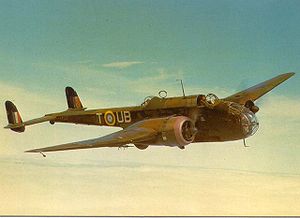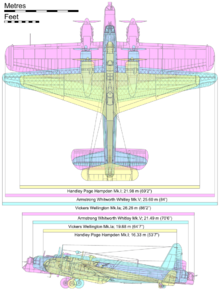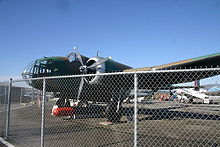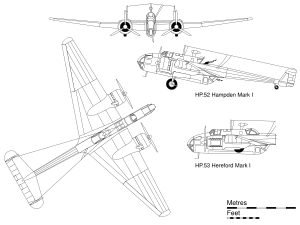Handley Page Hampden Video - World War II Video - Color
|
|
Handley Page Hampden
HP.52 Hampden

Picture - No. 455 Squadron (RAAF) Hampden
Role: Medium bomber
Manufacturer: Handley Page
Designed by: Gustav Lachmann
First flight: 21 June 1936
Introduction: 1938
Retired: 1945
Primary users: Royal Air Force
Royal Canadian Air Force
Soviet Naval Aviation
Royal Australian Air Force
Produced: 1936-1941
Number built: 1,430

Picture - Hampden Mk I
The Handley Page HP.52 Hampden was a British twin-engine medium bomber of the Royal Air Force serving in the Second World War. With the Whitley and Wellington, the Hampden bore the brunt of the early bombing war over Europe, taking part in the first night raid on Berlin and the first 1,000-plane raid on Cologne. The newest of the three medium bombers, the Hampden, known as the "Flying Suitcase" because of its cramped crew conditions, was still unsuited to the modern air war and, after operating mainly at night, it was retired from Bomber Command service in late 1942.
Design and development
Handley Page designed the Hampden to the same specification as the Wellington (Air Ministry Specification B.9/32) and the first prototype flew on 21 June 1936. The first production batch of 180 Mk I Hampdens was built to Specification 30/36.
The Mk I had a crew of four: pilot, navigator/bomb aimer, radio operator and rear gunner. Conceived as a fast, manoeuvrable, "fighting bomber", the Hampden had a fixed .303 in (7.7 mm) Vickers K machine gun in the forward fuselage. To avoid the weight penalties of powered-turrets, the Hampden had a curved Perspex nose fitted with a manual .303 in (7.7 mm) Vickers K gun and two more single .303 in (7.7 mm) Vickers K installations in the rear upper and lower positions. The layout was similar to the all-guns-forward cockpits introduced about the same time in the Luftwaffe's own medium bombers, notably the Dornier Do 17. The guns were thoroughly inadequate for defence, consequently, by 1940, the single guns had been replaced by twin Vickers K guns.
Construction was from sections prefabricated then joined. The fuselage was in three major sections - front, centre and rear. The centre and rear sections were themselves made of two halves. This meant the sections could be fitted out in part in better working conditions before assembly. In a similar the wings were made up of three large units - centre section, port outer wing and starboard outer wing - which were in turn sub-divided. The Hampden was a stressed skin design reinforced with a mixture of bent and extruded sections. The wing used a single main spar.
A total of 1,430 Hampdens were built: 500 by Handley Page, 770 by English Electric at Samlesbury in Lancashire; and in 1940-41, 160 in Canada by the Canadian Associated Aircraft consortium (although some were retained in Canada, 84 were shipped by sea to the United Kingdom).
Operational history

Picture - Scale comparison diagram of the trio of British twin-engined medium bombers at the outbreak of World War II; the Hampden, the Vickers Wellington and the Armstrong Whitworth Whitley.
No. 49 Squadron received the first Hampdens in September 1938. Flight Lieutenant Rod Learoyd of this squadron was awarded the Victoria Cross for the attack that he led on the Dortmund-Ems aqueduct on 12 August 1940. Sergeant John Hannah was the wireless operator/air gunner of an 83 Squadron Hampden; he was awarded the Victoria Cross on 15th September 1940 when he fought the flames of the burning aircraft, allowing the pilot to return it to base..
A total of 226 Hampdens were in service with eight squadrons by the start of the Second World War. Despite its speed and agility, in operational use the Hampden was no match for Luftwaffe fighters. Consequently, its career as a day bomber was brief, but Hampdens continued to operate at night on bombing raids over Germany, and mine-laying (code-named "gardening") in the North Sea.
Almost half of the Hampdens built - 714, were lost on operations, taking with them 1,077 crew killed and another 739 missing. German flak accounted for 108; one became the victim of a German barrage balloon; 263 Hampdens crashed because of "a variety of causes," and 214 others were classed as "missing." Luftwaffe pilots claimed 128 Hampdens, shooting down 92 at night. Guy Gibson spent most of the first two years of his wartime service flying Hampdens, and his book Enemy Coast Ahead gives a strong flavour of the trials and tribulations of taking these aircraft into action.
After being withdrawn from Bomber Command in 1942, it operated with Coastal Command through 1943 as a long-range torpedo bomber (the Hampden TB Mk I with a Mk XII torpedo in an open bomb-bay and a single 500 lb (230 kg) bomb under each wing) and as a maritime reconnaissance aircraft. No. 144 Squadron RAF and No. 455 Squadron RAAF were involved in the escort of Artic Convoy PQ-18 operating out of Soviet airbases and left their 23 aircraft in the USSR afterwards. These were then used by the 3rd Squadron of the 24 MTAP (Anti-shipping Wing) of the Soviet Navy until at least 1943. The Hampden was also used by the RCAF and the RNZAF.
After war service in Europe, about 200 "war-weary" Hampdens were flown to Canada where they were used for bombing and gunnery training.
Variants
The Hampden was powered by two 980 hp (730 kW) Bristol Pegasus XVIII nine-cylinder radial engines. A Mk II variant was developed as the HP.62 by converting two Hampdens to use the 1,000 hp (750 kW) Wright Cyclone engine in 1940 but no more was done of the project.
Interest in the HP.52 by the Swedish for placing a potential order led to the HP.53 prototype, which was subsequently used as a testbed for a pair of 1,000 hp (750 kW) Napier Dagger VIII 24-cylinder H-block air-cooled inline engines.
In 1936, the RAF ordered 150 Dagger-engined Hampdens as the Hereford. Problems with engine cooling resulted in most of those built (by Short & Harland) being re-engined as Hampdens. The surviving Herefords served in training units only.
Operators
H.P. Hampden
Australia
Royal Australian Air Force
No. 455 Squadron RAAF Used between July 1941 and December 1943, Codeletters UB
Canada
Royal Canadian Air Force
No. 408 (Goose) Squadron RCAF Used between July 1941 and September 1942, Codeletters EQ
No. 415 (Swordfish) Squadron RCAF Used between February 1942 and November 1943, Codeletters GX
No. 420 (Snowy Owl) Squadron RCAF Used between December 1941 and August 1942, Codeletters PT
No. 32 Operational Training Unit RCAF Used between May 1942 and February 1944, Codeletters DK, LB, OP and RO
New Zealand
Royal New Zealand Air Force
No. 489 Squadron RNZAF Used between February 1942 and November 1943, Codeletters XA
Soviet Union
Soviet Naval Aviation
No. 24 MTAP
Sweden
Swedish Air Force
Reconnaissance Wing F 11 based at Nykx¶ping operated a single HP.52 for evaluation under designation P 5. After the war aircraft was sold to SAAB where was operated for testing avionics.
United Kingdom
Royal Air Force
No. 7 Squadron RAF - April 1939 to April 1940, Codeletters LT (pre-War) and MG (Wartime)
No. 44 Squadron RAF - February 1939 and December 1941, Codeletters JW (pre-War) and KM (Wartime)
No. 49 Squadron RAF - October 1938 and April 1942, Codeletters XU (pre-War) and EA (Wartime)
No. 50 Squadron RAF - December 1938 and April 1942, Codeletters QX (pre-War) and VN (Wartime)
No. 61 Squadron RAF - February 1939 and October 1941, Codeletters LS (pre-War) and QR (Wartime)
No. 76 Squadron RAF - March 1939 and April 1940, Codeletters NM (pre-War) and MP (Wartime)
No. 83 Squadron RAF - November 1938 and January 1942, Codeletters QQ (pre-War) and OL (Wartime)
No. 97 Squadron RAF - July/August 1941, Squadron code OF
No. 106 Squadron RAF - March 1939 to March 1942, Codeletters XS (pre-War) and ZN (Wartime)
No. 144 Squadron RAF - March 1939 to October 1942, Codeletters NV (pre-War) and PL (Wartime)
No. 185 Squadron RAF - June 1939 to April 1940, Codeletters ZM (pre-War) and GL (Wartime)
No. 207 Squadron RAF - July/August 1941, Squadron Code EM
No. 517 Squadron RAF - August to November 1943,
No. 519 Squadron RAF - August to November 1943, Codeletters Z9
No. 521 Squadron RAF - September to December 1943, Codeletters 5O
No. 5 (C)OTU RAF Used between July 1942 and September 1943, Only individual Codeletters and numbers
No. 14 Operational Training Unit Used between 5 May 1940 and December 1942, Codeletters AM, GL and VB
No. 16 Operational Training Unit Used between 18 April 1940 and September 1942, Codeletters GA, JS and XG
No. 25 Operational Training Unit Used between February and December 1941, Codeletters ZP
No. 1401 (Meteorological) Flight RAF at RAF Bircham Newton/RAF Docking
No. 1402 (Meteorological) Flight RAF at Aldergrove
No. 1403 (Meteorological) Flight RAF at Gosport/Bircham Newton/Gibraltar
No. 1404 (Meteorological) Flight RAF at St. Eval
No. 1406 (Meteorological) Flight RAF at Wick
No. 1407 (Meteorological) Flight RAF at Reykjavik
H.P. Hereford
United Kingdom
Royal Air Force
No. 185 Squadron RAF at Cottesmore used in April 1940.
No. 14 Operational Training Unit at Cottesmore used from April 1940.
No. 16 Operational Training Unit at Upper Heyford, Oxfordshire, used from 7 May 1940.
Torpedo Development Unit at Gosport operated one aircraft.
Survivors

Picture - Hampden restoration project at the Canadian Museum of Flight at Langley, British Columbia c.2006
No Hampdens remain in flying condition today, although two wrecks are in the process of being restored.
Hampden I P1344 is under reconstruction in the UK. Shot down in Russia in 1942 and rediscovered and salvaged in 1991, the remains are held in the Michael Beetham Conservation Centre at the Royal Air Force Museum, Cosford.
Hampden, P5436, is being reconstructed largely from parts of the last Canadian-built example recovered from 600 feet of water in Saanich Inlet on Vancouver Island in 1989, as well as recovered components from two other Hampden crashes in Canada. The aircraft was ditched on a training flight in November 1942 when the pilot lost control after a practice torpedo drop. As of 2007, the reconstruction of the aircraft was about 97 per cent complete. The aircraft was to become the showpiece exhibit at the Canadian Museum of Flight at Langley, British Columbia, in the Fraser Valley, east of Vancouver. Unfortunately, in January 2009 a heavy snowfall snapped off the aircraft's left wing. Despite the efforts of Museum staff to clear the accumulating snow, the wing's internal structure failed and the wing separated from the fuselage, falling on to a display case containing one of the aircraft's original engines. The wing suffered considerable damage and there is additional damage to the tail. The wing had largely been restored using wood parts owing to the fact that most of the metal parts of the wing structure had been eroded, so it did not possess the structural integrity of the original aircraft. The museum is currently seeking donations to repair the aircraft.
The Hampden in popular culture
The HP Hampden had a featured role in the Big Blockade (1941) starring Michael Rennie, a Second World War propaganda film showing "blockade" bombing and its effects on the German war industry.
The trials of flying Hampdens in the early years of World War Two are also described in the 2002 book Damned Good Show by Derek Robinson.
There is also an issue of the comic Combat which focuses around a Hampden and its crew.
Specifications (Hampden Mk I)

Picture - 3-view projection of the Hampden Mark I, with inset detail of the Dagger-engined Hereford Mark I
Data from
General characteristics
Crew: 4
Length: 53 ft 7 in (16.33 m)
Wingspan: 69 ft 2 in (21.08 m)
Height: 14 ft 4 in (4.37 m)
Wing area: 688 ft² (63.9 m²)
Empty weight: 11,780 lb (5,344 kg)
Loaded weight: 18,756 lb (8,508 kg)
Powerplant: 2x Bristol Pegasus XVIII 9-cylinder radial engine, 980 hp (730 kW) each
Performance
Maximum speed: 265 mph (410 km/h) at 15,500 ft (4,724 m)
Range: 1,095 mi (1,762 km)
Service ceiling: 19,000 ft (5,790 m)
Rate of climb: 980 ft/min (300 m/min)
Wing loading: 27.3 lb/ft² (133 kg/m²)
Power/mass: 0.104 hp/lb (0.172 kW/kg)
Armament
Guns: 4-6 x .303 in (7.7 mm) Vickers K machine guns: one flexible and one fixed in the nose, one or two each in dorsal and ventral positions
Bombs: 4,000 lb (1,814 kg) bombs or 1 x 18 in (457 mm) torpedo or mines
Related development
Handley Page Hereford
Comparable aircraft
Armstrong Whitworth Whitley
Vickers Wellington
PZL.37 ÅoÅ
Related lists
List of aircraft of the RAF
List of aircraft of the RNZAF
Bibliography
Barnes, C.H. and Derek N. James. Handley Page Aircraft since 1907. London: Putnam & Company Ltd., 1987. ISBN 0-85177-803-8.
Bowyer, Chaz. Hampden Special. Shepperton, Surrey, UK: Ian Allan Ltd., 1976. ISBN 0-7110-0683-0.
Clayton, Donald C. Handley Page, an Aircraft Album. Shepperton, Surrey, UK: Ian Allan Ltd., 1969. ISBN 0-7110-0094-8.
Crosby, Francis. The World Encyclopedia of Bombers. London: Anness Publishing Ltd., 2007. ISBN 1-84477-511-9.
Day, Jerry. "Hurt Hampden." Air Classics, Volume 45, Issue 4, April 2009
Donald, David and Jon Lake, eds. Encyclopedia of World Military Aircraft. London: AIRtime Publishing, 1996. ISBN 1-880588-24-2.
Green, William. Famous Bombers of the Second World War. London: Macdonald and Jane's Publishers Ltd., 1977. ISBN 0-356-08333-0.
Green, William and Gordon Swanborough. WW2 Aircraft Fact Files: RAF Bombers, Part 2. London: Jane's Publishing Company Ltd., 2nd edition revised 1981. ISBN 0-7106-0118-2.
Gunston, Bill. Classic World War II Aircraft Cutaways. London: Osprey, 1995. ISBN 1-85532-526-8.
Mondey, David. The Hamlyn Concise Guide to British Aircraft of World War II. London: Hamlyn/Aerospace, 1982. ISBN 0-600-34951-9.
Moyes, Philip J.R. Bomber Squadrons of the RAF and their Aircraft. London: Macdonald and Jane's, 1964 (2nd edition 1976). ISBN 0-354-01027-1.
Moyes, Philip J.R. The Handley Page Hampden (Aircraft in Profile 58). Leatherhead, Surrey, UK: Profile Publications Ltd., 1965.
Moyes, Philip J.R. Royal Air Force Bombers of World War Two, Volume Two. Chalfont St. Giles, Buckinghamshire, UK: Hylton Lacy Publishers, 1968. ISBN 0-85064-000-8.
Moyle, Harry. The Hampden File. Tonbridge, UK: Air-Britain Historians Ltd., 1989. ISBN 0-85130-128-2.
Postlethwaite, Mark. Hampden Squadrons in Focus. Walton on Thames, UK: Red Kite, 2003. ISBN 0-9546201-0-0.
Roberts, Nicholas. Crash Log: Handley Page Hampden & Hereford. Earl Shilton, Leicestershire, UK: Midland Counties Publications, 1980. ISBN 0-904597-34-2.
Handley Page Hampden Pictures and Handley Page Hampden for Sale.
Living Warbirds: The best warbirds DVD series.
Source: WikiPedia